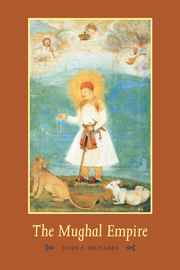Book contents
- Frontmatter
- Contents
- List of maps and tables
- General editor's preface
- Preface
- Introduction
- 1 Conquest and stability
- 2 The new empire
- 3 Autocratic centralism
- 4 Land revenue and rural society
- 5 Jahangir 1605–1627
- 6 Shah Jahan 1628–1658
- 7 The War of Succession
- 8 Imperial expansion under Aurangzeb 1658–1689
- 9 The economy, societal change, and international trade
- 10 Maratha insurgency and Mughal conquest in the Deccan
- 11 The Deccan Wars
- 12 Imperial decline and collapse, 1707–1720
- Conclusion
- Glossary
- Bibliographic essay
- Index
- THE NEW CAMBRIDGE HISTORY OF INDIA
Preface
Published online by Cambridge University Press: 28 March 2012
- Frontmatter
- Contents
- List of maps and tables
- General editor's preface
- Preface
- Introduction
- 1 Conquest and stability
- 2 The new empire
- 3 Autocratic centralism
- 4 Land revenue and rural society
- 5 Jahangir 1605–1627
- 6 Shah Jahan 1628–1658
- 7 The War of Succession
- 8 Imperial expansion under Aurangzeb 1658–1689
- 9 The economy, societal change, and international trade
- 10 Maratha insurgency and Mughal conquest in the Deccan
- 11 The Deccan Wars
- 12 Imperial decline and collapse, 1707–1720
- Conclusion
- Glossary
- Bibliographic essay
- Index
- THE NEW CAMBRIDGE HISTORY OF INDIA
Summary
The starting point for this volume is 1526, the date of Babur's victory at Panipat. The ending point is 1720, the date of Muhammad Shah's accession in Delhi. By the latter date the essential structure of centralized empire was disintegrated beyond repair. Behind my choice of 1720, rather than 1739, or 1761, or even 1803, is the belief that the collapse of the centralized formal apparatus of the Mughal empire was an important turning point in Indian history. Three decades of study have convinced me that Mughal centralized power was a reality and that its effect on Indian society was considerable. Whether this was good or bad is a different question. After 1720 the Mughal empire became a substantially different entity.
Within these dates I have tried to describe the construction of the Mughal empire, its operation, and its destruction. One of my aims has been to explain as clearly as possible the design and operation of the imperial system. This is no small matter, for generations of scholars have worked hard to try and decipher the intricacies of this enterprise.
Another goal has been to write a concise, coherent narrative history from 1526 to 1720. The narrative is conventional in that I trace the large public events, primarily political and military, that shaped imperial history. Partly this is because I believe that we ought to take the military history of the Mughal empire more seriously than is our current custom. After all, war was the principal business of the Mughal emperors, who committed by far the bulk of their resources to the military.
- Type
- Chapter
- Information
- The Mughal Empire , pp. xv - xviPublisher: Cambridge University PressPrint publication year: 1993

